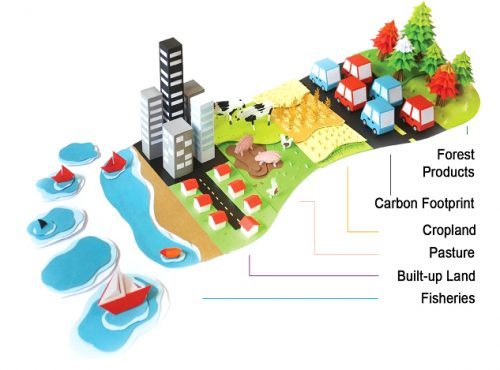Earth Overshoot Day marks the date when humanity’s demand for ecological resources and services in a given year exceeds what Earth can regenerate in that year. This ecological deficit spending is possible because we can liquidate stocks of ecological resources and accumulate waste, most prominently carbon dioxide in the atmosphere. As overspending can not last, overshoot will end. The question is only how: by design or disaster.
Every year, the date for Earth Overshoot Day is announced on June 5 (World Environment Day). This timing, just a couple of months before the event, ensures it reflects the most up-to-date data.
The event is hosted and calculated by Global Footprint Network, an international research organization that provides decision-makers with a menu of tools to help the human economy operate within Earth’s ecological limits. The calculation builds on the National Footprint and Biocapacity Accounts, which are governed by FoDaFo and maintained by York University. To estimate the year’s Earth Overshoot Day, latest data points are used to make the date reflect as accurately as possible the reality of the actual year. Every year, Global Footprint Network announces the date for Earth Overshoot Day of the running year on June 5, the date dedicated to World Environment Day.
To determine the date of Earth Overshoot Day for each year, Global Footprint Network calculates the number of days of that year that Earth’s biocapacity suffices to provide for humanity’s Ecological Footprint. The remainder of the year corresponds to global overshoot. Earth Overshoot Day is computed by dividing the planet’s biocapacity (the amount of ecological resources Earth is able to generate that year), by humanity’s Ecological Footprint (humanity’s demand for that year), and multiplying by the number of days in a year. 2025 is a non-leap year with 365 days:
(Earth’s Biocapacity / Humanity’s Ecological Footprint) x 365 = Earth Overshoot Day
Our calculations conclude that Earth Overshoot Day 2025 falls on July 24. Learn more about how the 2025 date was calculated. Or download the more detailed report here.
Explore and download the data for the world and every country at data.footprintnetwork.org.
Measuring Ecological Wealth

Source of Illustration: WWF Japan and Global Footprint Network; Ecological Footprint for Sustainable Living in Japan
Just as a bank statement tracks income against expenditures, Global Footprint Network measures a population’s demand for and ecosystems’ supply of resources and services. These calculations then serve as the foundation for calculating Earth Overshoot Day.
On the supply side, a city, state, or nation’s biocapacity represents its biologically productive land and sea area, including forest lands, grazing lands, cropland, fishing grounds, and built-up land.
On the demand side, the Ecological Footprint measures a population’s demand for plant-based food and fiber products, livestock and fish products, timber and other forest products, space for urban infrastructure, and forest to absorb its carbon dioxide emissions from fossil fuels.
Both measures are expressed in global hectares—globally comparable, standardized hectares with world average productivity. A hectare is equivalent to 10,000 square meters or 2.47 acres
Each city, state or nation’s Ecological Footprint can be compared to its biocapacity. If a population’s demand for ecological assets exceeds the supply, that region runs an ecological deficit. A region in ecological deficit meets demand by importing, liquidating its own ecological assets (such as overfishing), and/or emitting carbon dioxide into the atmosphere.
At the global level, ecological deficit and overshoot are the same, since there is no net import of resources to the planet.
History
The idea of Earth Overshoot Day was first suggested by our colleague and friend Andrew Simms, who then worked at the UK think tank New Economics Foundation. That Foundation then partnered with Global Footprint Network in 2006 to launch the first global Earth Overshoot Day campaign. Various organizations have partnered, including WWF, the world’s largest conservation organization, who have collaborated with Earth Overshoot Day since 2007. Since then, Earth Overshoot Day has grown exponentially and typically generates typically 7-10 billion media impressions every year, most of them in top-tier media. “Impressions” means number of people that those platforms who report about Earth Overshoot Day can reach.
More Resources
About the Ecological Footprint
About Ecological Overshoot
About Country Overshoot Days
About Country Deficit Days
Sign up for Global Footprint Network’s Newsletter
